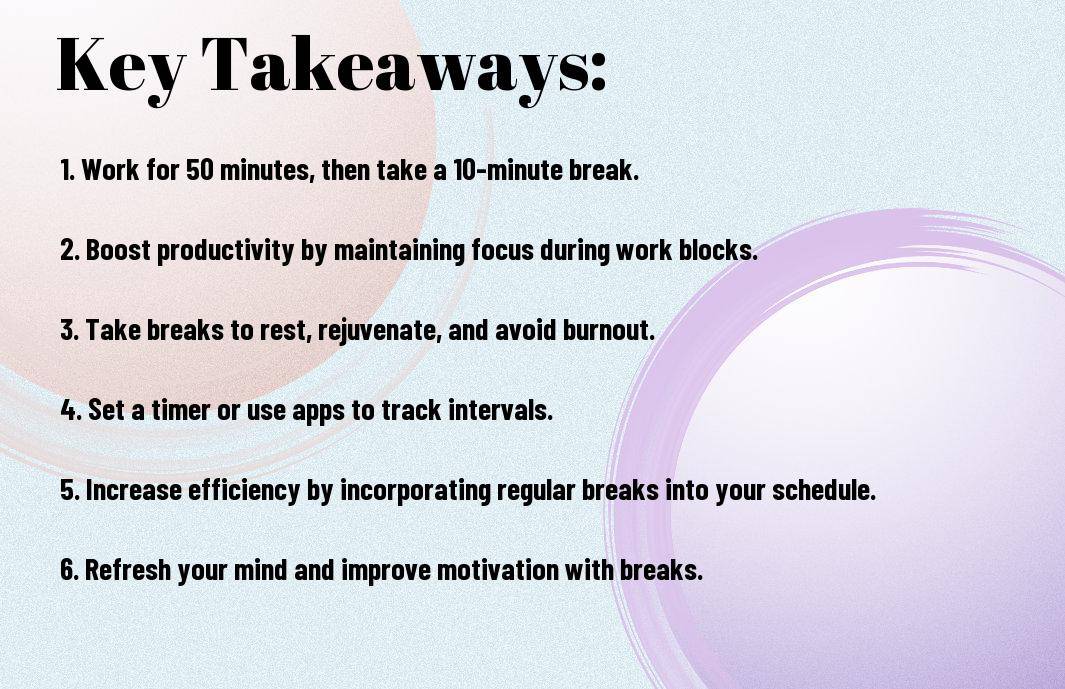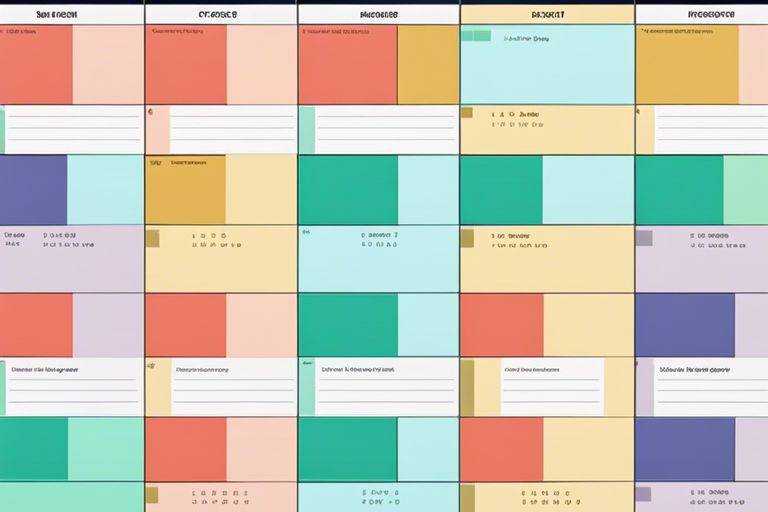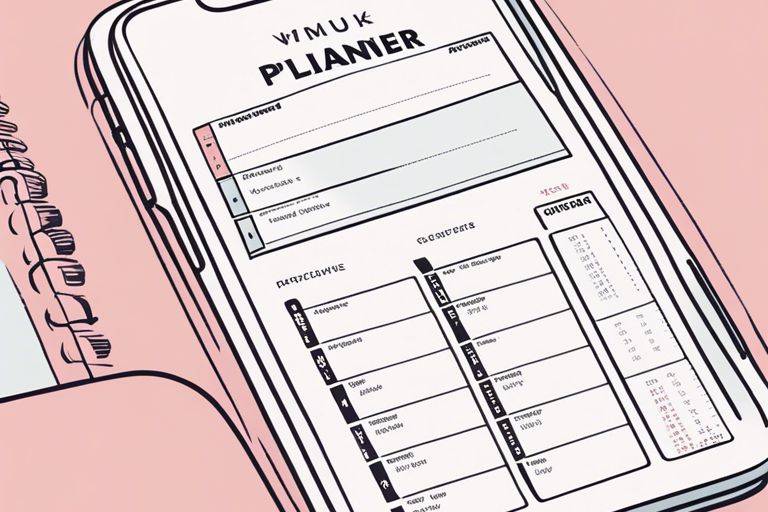You’ve probably heard of various techniques to boost productivity, but have you tried the 50/10 Rule? This method involves dedicating 50 minutes to focused work followed by a 10-minute break. Adhering to this cycle can drastically improve your efficiency and effectiveness in completing tasks.
By implementing the 50/10 Rule, you can ensure that you stay engaged and energized throughout your workday while also preventing burnout. This structured approach helps you make the most of your time and maximize productivity without sacrificing your well-being.
Key Takeaways:
- 50/10 Rule: The 50/10 rule suggests working for 50 minutes straight followed by a 10-minute break to optimize productivity.
- Structured Breaks: Breaking your work into intervals helps in maintaining focus and avoiding burnout.
- Enhanced Focus: By dedicating 50 minutes solely to work tasks without distractions, you can improve your concentration and efficiency.
- Effective Time Management: Implementing the 50/10 rule promotes better time management skills, allowing you to accomplish more in less time.
- Balance and Well-being: Regular breaks can help prevent mental fatigue, increase creativity, and maintain a healthy work-life balance.
- Adaptability: While the 50/10 rule is a popular technique, it’s important to adjust intervals based on personal preferences and tasks at hand.
- Consistency: Consistently applying the 50/10 rule can lead to a sustainable work routine that promotes productivity and well-being in the long run.

Understanding 50/10 Rule
Concept Overview
You’ll discover that the 50/10 rule is a time management technique that involves alternating between 50 minutes of focused work and 10 minutes of break time. This system is designed to help you maintain high levels of productivity and concentration throughout your workday.
Productivity Principle
Productivity is crucial for achieving your goals and completing tasks efficiently. By implementing the 50/10 rule, you can enhance your productivity levels by breaking your work into manageable chunks of time. This structured approach allows you to stay focused during work periods and recharge during break times, leading to better outcomes.
Understanding the 50/10 rule is key to unlocking your full potential and mastering time management. By following this principle, you can optimize your productivity, improve your concentration, and avoid burnout. The structured nature of this rule ensures that you are consistently making progress on tasks while also taking care of your well-being.

Benefits of 50/10 Rule
Increased Focus
Some productivity techniques focus on working for long stretches of time without breaks, but this can actually hinder our ability to concentrate. The 50/10 rule, however, ensures that we are periodically taking short breaks every 50 minutes, allowing us to recharge and come back to work with renewed focus. This approach helps prevent distractions and maintains optimum attention on the task at hand.
Reduced Burnout
Some individuals may feel the pressure to work non-stop in order to be productive, leading to burnout and decreased efficiency over time. There’s a misconception that pushing through without breaks leads to success, but in reality, it can result in stress and fatigue. The 50/10 rule encourages regular breaks, helping to prevent burnout and sustain productivity levels over the long term.
Focus: By incorporating regular breaks into our work routine, we can prevent burnout, maintain focus, and sustain high productivity levels throughout the day. Keep in mind, taking short breaks is not a sign of weakness but a strategy to enhance efficiency and well-being.

Implementing the Rule
Work Interval
Now is the time to implement the 50/10 Rule for managing your work and break times. Start by setting a timer for 50 minutes as your dedicated work interval. During this time, focus solely on the task at hand without any distractions. This focused work period allows you to make significant progress on your projects and tasks efficiently.
Break Interval
Implementing the break interval is equally crucial for maintaining productivity levels throughout the day. After completing a 50-minute work interval, take a 10-minute break to relax and recharge. Use this time to step away from your workspace, stretch your legs, hydrate, or engage in a quick mindfulness exercise.
Little do many realize that incorporating regular short breaks into your workday can actually enhance your overall productivity. By allowing your brain to rest and rejuvenate periodically, you can combat fatigue and prevent burnout, leading to improved focus and creativity when you return to work.
The key to success with the 50/10 Rule lies in adhering strictly to the prescribed work and break intervals. Consistency is imperative to reaping the full benefits of this time management technique, so stay committed to the schedule you set for yourself.

Workplace Application
Individual Use
Keep the 50/10 Rule in mind as you tackle your work tasks. By dedicating 50 minutes to focused work followed by a 10-minute break, you can enhance your productivity and mental clarity. Use this time to probe deeply into tasks without distractions, knowing a brief respite is on the horizon. During your breaks, step away from your workspace, stretch, hydrate, or engage in a quick mindfulness exercise to recharge.
Team Integration
You’ll find that implementing the 50/10 Rule within your team can revolutionize how tasks are accomplished. By syncing up break times, you can ensure that everyone is aligned on their pauses and return refreshed and focused. Application of this rule can help prevent burnout, boost creativity, and improve overall team performance. Encourage open communication within the team to ensure everyone adheres to the schedule and respects each other’s break times.
Team members can hold each other accountable and remind one another to take breaks regularly. By collectively embracing the 50/10 Rule, teams can cultivate a culture of productivity and well-being, leading to higher job satisfaction and quality of work produced. Keep in mind, a well-rested team is a high-performing team.
Time Management Tools
Timers
Not utilizing timers in your work routine can lead to inefficiency and burnout. You’ll find that setting specific time limits for tasks can help you focus and complete them more effectively. The 50/10 Rule can be easily implemented with the help of timers, where you work for 50 minutes and then take a 10-minute break.
Apps
With the advancement of technology, there are numerous apps available to assist you in managing your time better. For instance, apps like Toggl, RescueTime, and Forest can track your work hours, productivity levels, and even help you stay focused by blocking distracting websites. You’ll benefit from using these apps to stay organized and make the most out of your work and break times.
Challenges to 50/10 Rule
Distraction Handling
One of the biggest challenges to implementing the 50/10 Rule is handling distractions. In today’s fast-paced work environment, it’s easy to get sidetracked by emails, messages, social media notifications, and other interruptions. To stay focused during your 50-minute work period, it’s crucial to work in a distraction-free environment. This may mean turning off notifications, finding a quiet space to work, and setting boundaries with colleagues to minimize interruptions.
Work Nature
One challenge of the 50/10 Rule is that not all tasks can be neatly divided into 50-minute work periods. Some tasks may require a longer period of focus, while others may be more suited to shorter bursts of activity. Adapting the rule to fit the nature of your work is crucial for its successful implementation. Consider breaking down larger tasks into smaller chunks that can be completed in 50-minute intervals, or adjusting the rule to better suit tasks that require extended concentration.
It’s important to remember that the 50/10 Rule is a guideline and can be flexible based on your work needs. By understanding the challenges and adapting the rule to fit your work style and requirements, you can maximize productivity and efficiency.
Customizing the Rule
Now that you are familiar with the 50/10 Rule, it’s time to explore how you can personalize it to suit your unique work style and needs. Customizing the rule can help you maximize productivity and efficiency in a way that works best for you.
Personal Adaptation
For personal adaptation, consider factors such as your natural energy levels, attention span, and peak productivity hours. Some individuals may find that a 50-minute work session is too long, while others might feel they can push beyond the 50-minute mark with focus. Experiment with different work and break intervals to see what combination brings optimal results for you. Additionally, you may find it beneficial to incorporate personal interests or activities during break times to recharge and maintain motivation.
Workflow Considerations
Workflow considerations involve analyzing the nature of your tasks and responsibilities to ensure that the 50/10 Rule aligns with your workflow. Some tasks may require deep concentration and focus, making shorter work periods more suitable. On the other hand, tasks that are more repetitive or routine may benefit from longer work segments. It is crucial to tailor the rule to fit the demands of your work, allowing for seamless integration without disrupting your productivity flow.
With custom adjustments and thoughtful considerations, you can maximize the benefits of the 50/10 Rule to suit your personal preferences and optimize your workflow for enhanced productivity.
Work Intensity Variation
Task Complexity
Your workday is likely to consist of tasks with varying levels of complexity. Some tasks may be simple and repetitive, requiring less mental effort, while others are complex and demand focused concentration. It is crucial to recognize this variation in task complexity when planning your work and break times according to the 50/10 rule.
Energy Levels
Your energy levels fluctuate throughout the day, affecting your ability to focus and be productive. Assuming that you are most alert and energized at the start of your workday, it is recommended to tackle more challenging tasks during this time. As the day progresses, your energy levels may dip, making it the perfect opportunity to take a 10-minute break and recharge.
This strategy of aligning task complexity with your energy levels can help you optimize your productivity and efficiency. This mindful approach allows you to make the most of your high-energy periods for demanding tasks and leverage breaks during low-energy times to prevent burnout and maintain focus.
Combining Techniques
Pomodoro Method
Unlike the 50/10 rule, the Pomodoro technique breaks down work into intervals of focused activity followed by short breaks. The traditional Pomodoro method suggests 25 minutes of work followed by a 5-minute break. After four work intervals, a longer break of 15-30 minutes is recommended. This technique helps in managing distractions and fostering a sense of urgency to complete tasks within the set time frames.
Time Blocking
Techniques like time blocking involve scheduling specific tasks during designated time slots. By allocating blocks of time to different activities, you can ensure focused work on each task without distractions. This method helps in prioritizing activities, setting realistic deadlines, and maintaining a structured approach to work.
Blocking out dedicated time for important tasks can prevent procrastination and improve productivity. With time blocking, you can allocate slots for specific activities, such as emails, meetings, or creative work, ensuring each task receives the required attention and time commitment.
Rule’s Psychological Impact
Motivation Boost
If you often find yourself struggling to stay motivated throughout the workday, implementing the 50/10 Rule could be a game-changer for you. Breaking your work into focused 50-minute intervals followed by short 10-minute breaks can help you stay energized and engaged with your tasks. This structured approach not only enhances your productivity but also gives you a sense of accomplishment after each focused session. Knowing that a break is just around the corner can motivate you to stay on track and make the most out of your working hours.
Mental Health
If you often feel overwhelmed or burnt out from long periods of continuous work, the 50/10 Rule can greatly benefit your mental health. Regular breaks allow your mind to rest and recharge, reducing stress and preventing cognitive fatigue. By incorporating short breaks into your work routine, you can improve focus and concentration, leading to higher quality work and enhanced overall well-being.
Recall, taking care of your mental health is imperative for long-term productivity and success.
Physical Health Benefits
Once again, let’s investigate into the physical health benefits of incorporating the 50/10 rule into your workday routine. By taking regular breaks, you provide your body with the necessary movement and rest it needs to function optimally throughout the day.
Movement Encouragement
Even a short break every 50 minutes can make a significant difference in your physical health. Use this time to stretch, take a brisk walk, or do some quick exercises. Regular movement not only boosts your blood circulation and increases energy levels, but it also helps prevent muscle stiffness and joint pain that can result from prolonged sitting.
Eye Strain Reduction
An vital part of the 50/10 rule is giving your eyes a break from staring at screens. Screen time can contribute to digital eye strain, which may lead to headaches, dry eyes, and blurred vision. By following the 50/10 rule, you can significantly reduce the strain on your eyes and improve your overall eye health.
You can combat eye strain during your 10-minute breaks by looking away from your screen and focusing on objects at a distance. Additionally, consider blinking more frequently to keep your eyes moist and reduce irritation.
Academic Applications
Despite the busy academic schedule, students can benefit greatly from implementing the 50/10 Rule to enhance their productivity and focus. By dedicating 50 minutes to focused study followed by a 10-minute break, students can maximize their study sessions, retain information better, and avoid burnout.
Student Strategy
The key to successful implementation of the 50/10 Rule lies in proper time management and self-discipline. As a student, it is crucial to prioritize tasks, set specific study goals for each session, and utilize the break time effectively. Use the 10-minute break to relax, stretch, hydrate, or engage in a quick physical activity to boost energy levels for the next study session.
Study Habits
There’s a common misconception that longer study hours equate to better academic performance. However, research has shown that short, focused study sessions interspersed with breaks can lead to improved information retention and overall productivity. By incorporating the 50/10 Rule into your study habits, you can enhance concentration, reduce distractions, and maintain a steady level of focus throughout your study sessions.
You can also experiment with different study environments to find what works best for you. Some students may prefer studying in a quiet library, while others might thrive in a café with ambient noise. Finding the optimal study setting can further boost your productivity and make the most out of your study sessions.
Avoiding Overwork
All work and no play can lead to burnout and decreased productivity. It is crucial to find a balance between work and relaxation to maintain optimal performance. In this chapter, we will discuss strategies to avoid overwork and ensure you stay productive without sacrificing your well-being.
Setting Boundaries
Any successful professional knows the importance of setting boundaries. Whether it’s establishing specific work hours, saying no to extra tasks when your plate is already full, or disconnecting from work emails after a certain time, setting boundaries is important. Overworking can not only lead to decreased productivity but also harm your mental and physical health. By clearly defining when work starts and ends, you can create a structure that allows for adequate rest and rejuvenation.
Recognizing Limits
Any ambitious individual may find it challenging to admit when they have reached their limit. However, recognizing your limits is crucial to maintaining a healthy work-life balance. Pushing past your limits can lead to burnout, which can have long-term negative effects on your overall well-being. With the 50/10 Rule, you are encouraged to recognize when you are reaching a point of diminishing returns and take a break to recharge. This self-awareness will ultimately lead to increased productivity and job satisfaction.
With the demands of modern work environments, it can be easy to fall into the trap of overworking. By recognizing your limits and setting boundaries, you can protect yourself from burnout and maintain a healthy work-life balance. Keep in mind, productivity is not about how many hours you put in, but the quality of work you produce in the time you allocate.
Enhancing Task Quality
Attention to Detail
On a quest to enhance task quality, one must pay attention to detail. Despite seeming minuscule, details play a vital role in the overall outcome of a task. It is the attention given to the small components that can make a significant impact on the final result. By focusing on the details, individuals can identify errors, make necessary corrections, and ultimately produce a higher quality of work.
Mindful Working
Enhancing task quality also involves practicing mindful working. On being mindful, individuals are fully present and engaged in the task at hand. This level of awareness helps in avoiding mistakes, improving focus, and fostering a deeper understanding of the work being done. Plus, mindful working promotes a sense of satisfaction and accomplishment, as individuals can witness the direct impact of their efforts on the quality of their work.
Break Activities
After a focused work session following the 50/10 rule, it’s necessary to engage in activities during your break times that will help rejuvenate your energy levels and improve your overall productivity. This chapter will explore two key categories of break activities – quick exercises and relaxation techniques.
Quick Exercise
Clearly, engaging in quick exercises during your break time can have numerous benefits for both your physical and mental well-being. A brisk walk around your workspace, a set of jumping jacks, or a few minutes of stretching can help improve blood circulation, reduce muscle tension, and boost your energy levels. These simple exercises can also help clear your mind, enhance focus, and increase productivity when you return to work.
Relaxation Techniques
Break time is also an excellent opportunity to practice relaxation techniques that can help reduce stress and promote a sense of calm. Techniques such as deep breathing, progressive muscle relaxation, or mindfulness meditation can be highly effective in combatting the negative effects of prolonged sitting and intense mental focus. Taking just a few minutes to engage in these relaxation practices can have a profound impact on your well-being and productivity.
It is important to prioritize break activities that help you relax and recharge during your designated break times. By incorporating quick exercises and relaxation techniques into your routine, you can effectively manage your energy levels, improve focus, and enhance your overall productivity throughout the day.
Goal Setting
To effectively manage your work and break times using the 50/10 Rule, goal setting is crucial. Setting clear and achievable goals helps you stay focused and motivated throughout your workday. By breaking down your larger objectives into smaller, more manageable tasks, you can track your progress and ensure you stay on target.
Short-Term Milestones
On a daily basis, set specific short-term milestones that align with your overall goals. These milestones should be achievable within the 50-minute work intervals you have scheduled. Consider what tasks you need to complete to make progress towards your larger objectives. By reaching these milestones, you’ll build momentum and stay motivated to continue being productive.
Long-Term Objectives
You’ll want to establish long-term objectives that provide a sense of direction and purpose to your work. These goals should be challenging yet attainable, pushing you to strive for continued growth and development. By setting long-term objectives, you create a roadmap for your future success and ensure that your daily efforts are contributing to your overall vision.
ShortTerm: By setting clear short-term milestones and long-term objectives, you can effectively manage your time and work towards accomplishing your goals with purpose and intention.
Rule’s Limitations
Variability in Effectiveness
Not all individuals respond the same way to the 50/10 Rule. While some people may thrive on this structured approach to work and break times, others may find it too rigid and restrictive. Factors such as individual work habits, attention span, and task complexity can influence the effectiveness of this time management technique. It is important for individuals to experiment with the rule and adjust it according to their own needs and preferences.
Potential Inefficiencies
For some individuals, adhering strictly to the 50/10 Rule may lead to potential inefficiencies. Breaking work into rigid 50-minute blocks may not always align with the natural flow of tasks or creativity. Certain projects may require longer periods of focused work without interruptions, while others may benefit from shorter, more frequent breaks. It is important for individuals to assess the nature of their work and adjust the rule accordingly to avoid inefficiencies.
Any time management technique has its limitations, and the 50/10 Rule is no exception. It is crucial for individuals to recognize the nuances of their own work styles and adapt the rule to suit their needs. Flexibility and self-awareness are key in determining the effectiveness of this time management strategy. By understanding the potential limitations of the rule and making necessary adjustments, individuals can maximize their productivity and enhance their overall work performance.
Success Stories
To effectively implement the 50/10 Rule and witness its productivity benefits, it’s crucial to look at the success stories of companies and individuals who have embraced this method. By understanding their experiences, you can gain insights on how to optimize your work and break times for enhanced productivity.
Company Case Studies
You’ll find that numerous companies across various industries have reaped the benefits of the 50/10 Rule. Implementing this strategy has led to increased productivity, improved employee satisfaction, and enhanced work-life balance. Here are some notable case studies showcasing the positive impact of the 50/10 Rule:
- Company A: Witnessed a 20% increase in project completion rates after implementing the 50/10 Rule.
- Company B: Reported a 15% reduction in employee burnout and a 10% rise in overall output efficiency.
- Company C: Saw a 25% improvement in team collaboration and communication as a result of structured break times.
Personal Testimonies
If you’re curious about how individuals have benefitted from the 50/10 Rule on a personal level, exploring their personal testimonies can provide valuable insights. Many professionals have experienced increased focus, reduced stress levels, and improved creativity by adhering to this time management technique.
For instance, hearing firsthand accounts of individuals who have successfully implemented the 50/10 Rule can inspire you to make positive changes in your own work routine. Their experiences can serve as a motivating factor to take control of your time and prioritize both work tasks and rest periods for optimal productivity.
Adapting to Changes
Flexible Implementation
For some individuals, sticking to a rigid schedule may not always be feasible. Life is full of unexpected events and responsibilities that can disrupt even the best-laid plans. The key to successfully implementing the 50/10 rule is to be flexible in your approach. Instead of becoming frustrated when things don’t go according to plan, adapt to the changes and find ways to make the rule work for you.
Continuous Improvement
One of the core principles of the 50/10 rule is the idea of continuous improvement. As you start incorporating this rule into your daily routine, you may notice areas where you can make adjustments to further enhance your productivity. It’s important to evaluate how well the rule is working for you and be open to making changes as needed. Whether it’s shifting the length of your work intervals or re-evaluating how you spend your break times, continuous improvement is key to maximizing the benefits of this technique.
The process of continuous improvement involves being flexible and willing to experiment with different approaches until you find what works best for you. It’s about making small tweaks to your routine to achieve optimal productivity levels and ensure that you are making the most of your time.
Tracking Progress
Many people find it challenging to track their progress effectively when implementing the 50/10 rule. However, measuring your productivity and break times is crucial to ensure you are optimizing your workflow. By tracking your progress, you can identify patterns, areas for improvement, and whether you are adhering to the 50/10 ratio effectively.
Measurement Methods
To measure your progress accurately, consider using time tracking tools or apps that can monitor the time you spend on tasks versus your break times. These tools can provide detailed insights into how you allocate your time throughout the day, allowing you to make data-driven decisions to improve your productivity. Additionally, keeping a written log or journal can also be effective in tracking your progress manually.
Reflection Habits
To enhance the effectiveness of tracking your progress, it is necessary to develop reflection habits. Take time at the end of each day to review how you utilized your work and break times. Reflect on what worked well, what didn’t, and how you can make adjustments moving forward. This habit of reflection can help you fine-tune your schedule and ensure you are making the most out of the 50/10 rule.
An important aspect of reflection habits is to be honest with yourself about your productivity levels. Acknowledge areas where you may be slacking off during work periods or not taking adequate breaks. By recognizing these patterns, you can proactively address them and make changes to improve your overall productivity.
Conclusion
The 50/10 Rule is a powerful method for improving productivity and managing work and break times effectively. By focusing on short bursts of concentrated work followed by brief breaks, individuals can enhance their efficiency, reduce mental fatigue, and maintain a high level of productivity throughout the day. Implementing this principle can lead to increased motivation, better work-life balance, and improved overall performance.
The 50:10 Principle: A Proven Method To Get Done More offers a structured approach to managing time and maximizing output. By incorporating regular breaks into the work routine, individuals can optimize their focus, creativity, and energy levels, resulting in more efficient task completion and a higher quality of work. Embracing the 50/10 Rule can lead to increased productivity and a more balanced approach to work, ultimately leading to greater success and satisfaction in both professional and personal endeavors.
FAQ
Q: What is the 50/10 Rule?
A: The 50/10 Rule is a time management technique that involves working for 50 minutes and then taking a 10-minute break to help enhance productivity and focus.
Q: How does the 50/10 Rule help in managing work and break times?
A: The 50/10 Rule helps in managing work and break times by providing structured intervals for work and rest, which can boost productivity, improve concentration, and prevent burnout.
Q: Why is it important to take regular breaks while working?
A: Taking regular breaks while working is important as it helps to prevent fatigue, maintain focus, improve creativity, reduce stress, and enhance overall productivity.
Q: How can I implement the 50/10 Rule effectively?
A: To implement the 50/10 Rule effectively, schedule your work tasks into 50-minute intervals, focus solely on work during those intervals, and then take a 10-minute break to rest and recharge before starting the next work session.
Q: What are some activities I can do during the 10-minute break?
A: During the 10-minute break, you can engage in activities like stretching, walking, deep breathing exercises, listening to music, meditating, or grabbing a healthy snack to relax and rejuvenate your mind and body.
Q: Can the 50/10 Rule be adjusted to suit individual preferences?
A: Yes, the 50/10 Rule can be adjusted to suit individual preferences. Some people may find that shorter work intervals with more frequent breaks work better for them, while others may prefer longer work sessions with longer breaks.
Q: What are the potential benefits of following the 50/10 Rule consistently?
A: Consistently following the 50/10 Rule can lead to increased productivity, improved concentration, enhanced creativity, reduced stress levels, better work-life balance, and overall well-being in the long run.
Expand Your Knowledge
Unmatched Productivity – Ultimate Guide to Harnessing Your Second Brain
Eat That Frog – Brian Tracy’s Approach to Tackling the Most Challenging Task First
Pomodoro Technique – Francesco Cirillo’s Method to Improve Focus and Manage Time
Unlocking the Zeigarnik Effect: How Bluma Zeigarnik’s Open Tasks Can Skyrocket Your Motivation
Night Before Planning – Preparing for Next-Day Productivity the Night Before



